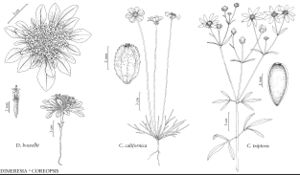Coreopsis
Sp. Pl. 2: 907. 1753.
Gen. Pl. ed. 5, 388. 1754.
Annuals, perennials, subshrubs, or shrubs, 10–80 (–200+) cm (often rhizomatous or with cormiform bases, stoloniferous in C. auriculata). Stems usually 1, erect, branched distally or ± throughout. Leaves basal, basal and cauline, or cauline; opposite or alternate or both; petiolate or sessile; blades simple and entire (dentate in C. latifolia), or ± pinnately or pedately lobed, faces glabrous or hairy. Heads radiate, borne singly or in open, ± corymbiform arrays. Calyculi of (3–) 8+, distinct, ± herbaceous bractlets. Involucres ± globose to cylindric, 4–25+ mm diam. Phyllaries usually ± 8 in ± 2 series (usually distinct, rarely connate ± 1/10 their lengths, mostly oblong to linear, ± membranous, margins ± scarious). Receptacles flat to convex, paleate; paleae falling, ovate to linear or subulate, ± flat, ± scarious (not adnate to and not falling with cypselae except in C. bigelovii). Ray-florets mostly (5–) 8 (–12+, more in “double” cultivars), neuter, or styliferous and sterile, or pistillate and fertile; corollas usually yellow, sometimes redbrown to purple proximally, sometimes wholly purple or pink to white. Disc-florets 8–150+, bisexual, fertile; corollas usually yellow, sometimes redbrown to purple at tips or throughout, tubes equaling or shorter than narrowly funnelform throats, lobes 4 or 5 (adaxial sinus seldom deeper than others). Cypselae obcompressed, ± orbiculate to ovate, oblong, or linear, usually thin-margined or winged, wings membranous to chartaceous or corky, entire or lobed to toothed, sometimes ciliolate; faces smooth or ± papillate to tuberculate; pappi 0, or persistent, of 2 bristly cusps or scales (sometimes pappi 0 and shoulders of cypsela wings ± bristly, pappuslike). x = 14.
Distribution
Mostly temperate North America, also tropical New World and Old World. Early leaves of some coreopsises often differ from later leaves on individual plants
Discussion
Species ca. 35 (28 in the flora).
Early leaves of some coreopsises often differ from later leaves on individual plants. In such plants, early (proximal) leaves may be 1–3-pinnately or pedately lobed and 12–25+ cm long with 9–15+ orbiculate to lanceolate, linear, or filiform lobes and contrast markedly with later (distal) leaves 1–3 cm that are undivided or have 3–5+ lanceolate to linear or filiform lobes.
Cultivars (often “doubles” with multiple series of “ray” florets) derived from Coreopsis auriculata, C. grandiflora, C. lanceolata, and C. tinctoria are grown in public and residential gardens and are grown commercially for cut flowers.
Selected References
Lower Taxa
Key
| 1 | Ray florets usually pistillate and fertile, sometimes styliferous and sterile | > 2 |
| 1 | Ray florets neuter (without styles) | > 4 |
| 2 | Perennials, subshrubs, or shrubs; ray laminae ± elliptic to oblong, broadest at or near middles | Coreopsis sect. Tuckermannia |
| 2 | Annuals; ray laminae obovate to ± flabellate, broadest distal to middles | > 3 |
| 3 | Cypselae of disc florets ciliolate; pappi of 2 lanceolate to subulate scales | Coreopsis sect. Pugiopappus |
| 3 | Cypselae of disc florets not ciliolate; pappi 0 or coroniform (0.1–0.2 mm) | Coreopsis sect. Leptosyne |
| 4 | Leaf blades usually not lobed, rarely with 1–2 auricles at bases (margins dentate); rayflorets 4–5; disc florets 10–15+ | Coreopsis sect. Silphidium |
| 4 | Leaf blades sometimes lobed (ultimate margins not dentate); ray florets (5–)8(–13; more in "double" cultivars); disc florets 30–150+ | > 5 |
| 5 | Disc corolla lobes 5; style-branch apices usually ± penicillate, sometimes short-conic or truncate-mucronate | > 6 |
| 5 | Disc corolla lobes 4; style-branch apices ± truncate | > 7 |
| 6 | Ray laminae ± oblong-elliptic to suborbiculate, broadest at or near middles; paleae usually linear to subulate, often distally dilated | Coreopsis sect. Gyrophyllum |
| 6 | Ray laminae ± cuneate, broadest distal to middles; paleae basally ± lanceolate to linear, distally attenuate (± filiform) | Coreopsis sect. Coreopsis |
| 7 | Leaf blades sometimes with 1–2 lateral lobes; cypselae sometimes winged, wings ± pectinate or toothed | Coreopsis sect. Eublepharis |
| 7 | Leaf blades usually 1–2(–3)-pinnately lobed; cypselae sometimes winged, wingsentire | Coreopsis sect. Calliopsis |
"broader" is not a number.

